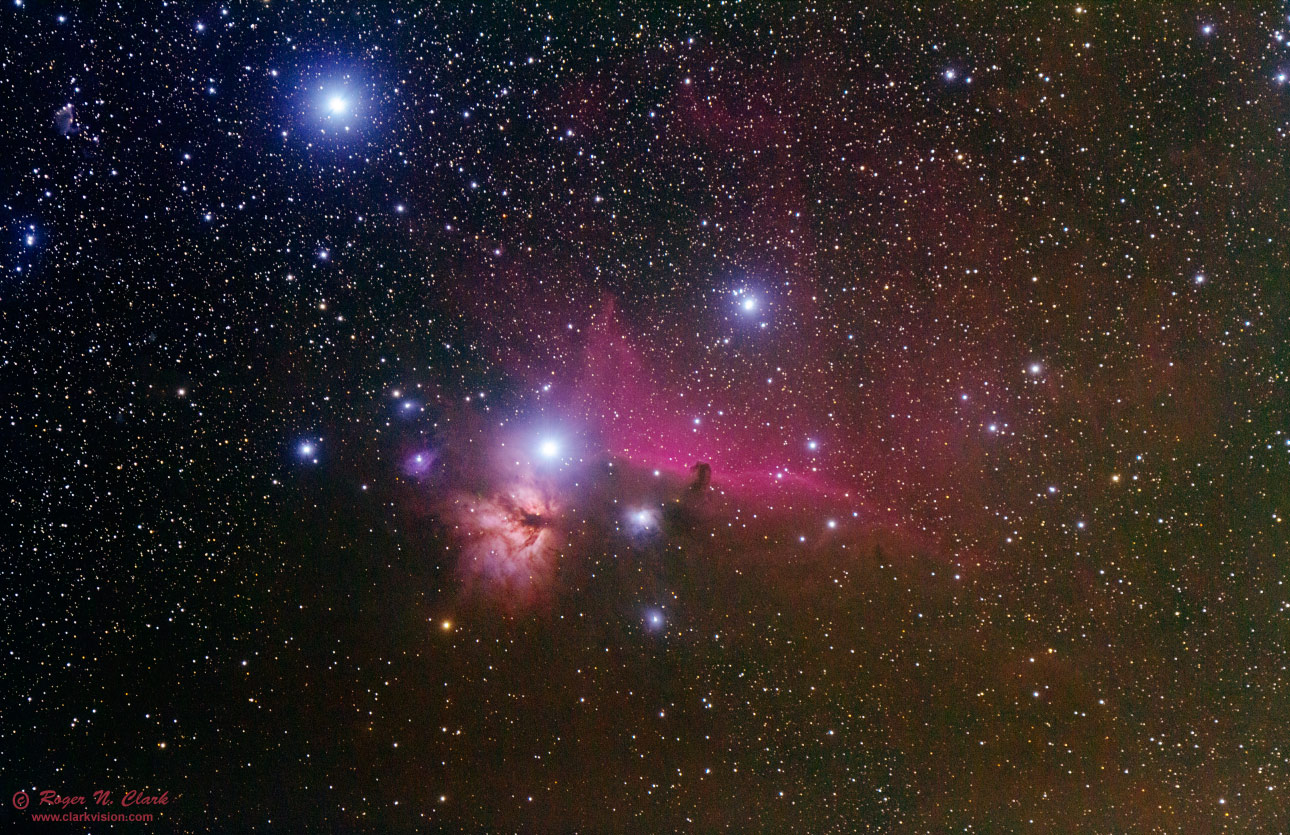| Home | Galleries | Articles | Reviews | Best Gear | New | About | Contact | Gallery Index | Previous |
Next |

| Home | Galleries | Articles | Reviews | Best Gear | New | About | Contact | Gallery Index | Previous |
Next |

The beautiful Horsehead nebula (center) is made of dark dust in front of an emission nebula (red). The bright nebula to the lower left of the Horsehead is the emission nebula NGC 2024. The bright star at upper left is the middle star in Orion's belt, called Alnilam, and the bright star to the left of the Horsehead and above NGC 2024 is the eastern end star of Orion's belt. Note the small galaxy near the upper left corner.
The full resolution image shows stars as faint as about magnitude 19. The brightest star is the upper belt star, Alnilam, which is magnitude 1.65, giving a dynamic range of the scene of over 8.7 million, (23 photographic stops). The Horsehead nebula is visible in 8-inch diameter telescopes from a dark site, but the detail shown in this image would require about a 1-meter aperture (about 40-inch) telescope to see.
Technical. Canon 7D 18-megapixel digital camera, Canon 300 mm f/2.8 lens at f/2.8. Fifteen 62-second exposures at ISO 1600 were added (15.5 minutes total exposure). No dark frame subtraction, no flat fields, no noise reduction. Tracking with an astrotrac. The horsehead is a very faint nebula, so this image demonstrates that the 7D is a great low light camera for it to record so much detail in such a short exposure.
The Exposure Factors, CEF, CEFA are measures of the relative amounts of light received from a subject. It can be used to fairly compare wildly different lens/telescope apertures and exposure times. For this image:
Modern DSLRs like the 7D include on sensor dark current suppression and low fixed pattern noise at ISOs around 1600 and higher, making no need for dark frame subtraction. Modern raw converters correct for light fall-off and also correct for hot/dead/stuck pixels. This makes processing low light images easy: simply align and average.
The color balance is true color, meaning this is a stock camera with very close spectral response similar to the human eye. Astrophotographers often modify cameras for increased sensitivity to Hydrogen-alpha emission (red). Hydrogen emission nebulae actually appear pink due to H-alpha (red), H-beta (blue) and emission from other atoms, like oxygen and sulfur. Modified cameras over emphasize H-alpha, making hydrogen emission nebulae come out red in photos. The orange in the image is the color from dust. Unmodified cameras do a better job at color separation of the various processes that occur in the deep sky. Modified cameras tend to show mostly red in areas like that in this image, making it too difficult to tell the difference between dust and hydrogen emission nebulae.
To learn how to obtain stunning images like this, please visit my Extensive Articles on Photography .
Keywords to this image = astrophoto-1 nebula low-light digital_astro
Image ID: horsehead.300mm.rnclark.c10.09.2013.IMG_1850-69.d-bin4x4s.jpg
| Home | Galleries | Articles | Reviews | Best Gear | Science | New | About | Contact |
Last updated December 20, 2025